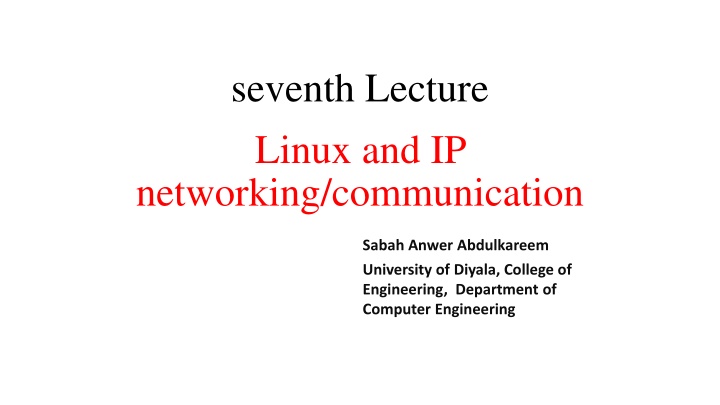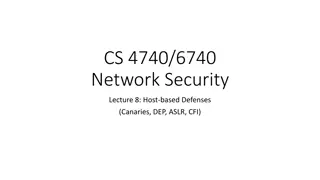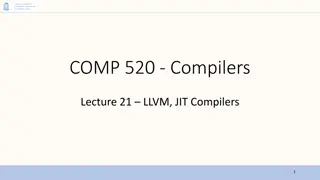
TCP/IP Protocols in Linux Networking
Explore the utilization of TCP/IP protocols in Linux networking, including Transmission Control Protocol (TCP), User Datagram Protocol (UDP), and Internet Control Message Protocol (ICMP). Learn how different protocols function within the TCP/IP family to facilitate secure and efficient data transfer. Delve into the layer model of TCP/IP to grasp the hierarchy of data transfer mechanisms.
Download Presentation

Please find below an Image/Link to download the presentation.
The content on the website is provided AS IS for your information and personal use only. It may not be sold, licensed, or shared on other websites without obtaining consent from the author. If you encounter any issues during the download, it is possible that the publisher has removed the file from their server.
You are allowed to download the files provided on this website for personal or commercial use, subject to the condition that they are used lawfully. All files are the property of their respective owners.
The content on the website is provided AS IS for your information and personal use only. It may not be sold, licensed, or shared on other websites without obtaining consent from the author.
E N D
Presentation Transcript
seventh Lecture Linux and IP networking/communication Sabah Anwer Abdulkareem University of Diyala, College of Engineering, Department of Computer Engineering
TCP/IP TCP/IP The Protocol Used by Linux The Protocol Used by Linux Linux and other Unix operating systems use the TCP/IP protocol. It is not a single network protocol, but a family of network protocols that offer various services. TCP/IP was developed based on an application used for military purposes and was defined in its present form in an RFC in 1981.
Table 14.1. Several Protocols in the TCP/IP Protocol Family Protocol Description Transmission Control Protocol: A connection-oriented secure protocol. The data to transmit is first sent by the application as a stream of data then converted by the operating system to the appropriate format. The data arrives at the respective application on the destination host in the original data stream format in which it was initially sent. TCP determines whether any data has been lost during the transmission and that there is no mix-up. TCP is implemented wherever the data sequence matters. TCP User Datagram Protocol: A connectionless, insecure protocol. The data to transmit is sent in the form of packets already generated by the application. The order in which the data arrives at the recipient is not guaranteed and data loss is a possibility. UDP is suitable for record- oriented applications. It features a smaller latency period than TCP. UDP Internet Control Message Protocol: Essentially, this is not a protocol for the end user, but a special control protocol that issues error reports and can control the behavior of machines participating in TCP/IP data transfer. In addition, a special echo mode is provided by ICMP that can be viewed using the program ping. ICMP Internet Group Management Protocol: This protocol controls the machine behavior when implementing IP multicast. The following sections do not contain more information regarding IP multicasting, because of space limitations. IGMP
Almost all hardware protocols work on a packet-oriented basis. The data to transmit is packaged in packets, as it cannot be sent all at once. This is why TCP/IP only works with small data packets. The maximum size of a TCP/IP packet is approximately 64 kilobytes. The packets are normally quite a bit smaller, as the network software can be a limiting factor. The maximum size of a data packet on an ethernet is about fifteen hundred bytes. The size of a TCP/IP packet is limited to this amount when the data is sent over an ethernet. If more data is transferred, more data packets need to be sent by the operating system.
Layer Model Layer Model IP (Internet Protocol) is where the insecure data transfer takes place. TCP (Transmission Control Protocol), to a certain extent, is simply the upper layer for the IP platform serving to guarantee secure data transfer. The IP layer itself is, in turn, supported by the bottom layer, the hardware-dependent protocol, such as ethernet. Professionals refer to this structure as the layer model. Figure 14.1. Simplified Layer Model for TCP/IP
Figure Figure : : Simplified Layer Model for TCP/IP Simplified Layer Model for TCP/IP
. The special functions of each layer While layer 1(the physical layer) deals with cable types, signal forms, signal codes, and the like, layer 2 (the data link layer )is responsible for accessing procedures (which host may send data?) and error correction Layer 3 is the network layer and is responsible for remote data transfer. The network layer ensures that the data arrives at the correct remote destination and can be delivered to it.
Layer 4, the transport layer, is responsible for application data. It ensures that data arrives in the correct order and is not lost. While the data link layer is only there to make sure that the data as transmitted is the correct one, the transport layer protects it from being lost. Finally, layer 5 is the layer where data is processed by the application itself. For every layer to serve its designated function, additional information regarding each layer must be saved in the data packet. This takes place in the header of the packet. Every layer attaches a small block of data, called the protocol header, to the front of each emerging packet. A sample TCP/IP data packet traveling over an ethernet cable is illustrated inFigure 14.2. TCP/IP Ethernet Packet
Figure Figure : :TCP/IP TCP/IP Ethernet Packet Ethernet Packet
The proof sum is located at the end of the packet, not at the beginning. This simplifies things for the network hardware. The largest amount of usage data possible in one packet is 1460 bytes in an ethernet network. When an application sends data over the network, the data passes through each layer, all implemented in the Linux kernel except layer 1 (network card). Each layer is responsible for preparing the data so it can be passed to the next layer below. The lowest layer is ultimately responsible for sending the data. The entire procedure is reversed when data is received. Like the layers of an onion, in each layer the protocol headers are removed from the transported data. Finally, layer 4 is responsible for making the data available for use by the applications at the destination. In this manner, one layer only communicates with the layer directly above or below it. For applications, it is irrelevant whether data is transmitted via a 100 MBit/s FDDI network or via a 56-kbit/s modem line. Likewise, it is irrelevant for the data line which kind of data is being transmitted, as long as packets are in the correct format.
IP IP Addresses Addresses Every computer on the Internet has a unique 32-bit address. These 32 bits (or 4 bytes) are normally written as illustrated in the second row in Table how an IP Address is written















